Photo gallery
- Mary McLeod Bethune sculpture
- Martin Luther King, Jr. bust in Capitol Rotunda
Artworks commemorating African-Americans in Washington, D.C. is a group of fourteen public artworks in Washington, D.C., including the Martin Luther King, Jr. Memorial dedicated in 2011, that commemorate African Americans. [1] When describing thirteen of these that predate the King Memorial, Jacqueline Trescott wrote for The Washington Post :
In a city crowded with memorials and monuments, few represent the individual struggles of African American pioneers or salute the contributions of black citizens. [1]
Trescott reported that four additional commemorative works also include representations of African Americans. [1]
Trescott reported that the following works commemorate African Americans. [1] https://en.wikipedia.org/wiki/ Octavius_Catto
Trescott reported that the following memorials contain additional representations of African Americans. [1]
African American:

The National Statuary Hall Collection in the United States Capitol is composed of statues donated by individual states to honor persons notable in their history. Limited to two statues per state, the collection was originally set up in the old Hall of the House of Representatives, which was then renamed National Statuary Hall. The expanding collection has since been spread throughout the Capitol and its Visitor's Center.

The National Council of Negro Women, Inc. (NCNW) is a nonprofit organization founded in 1935 with the mission to advance the opportunities and the quality of life for African-American women, their families, and communities. Mary McLeod Bethune, the founder of NCNW, wanted to encourage the participation of Negro women in civic, political, economic and educational activities and institutions. The organization was considered as a clearing house for the dissemination of activities concerning women but wanted to work alongside a group that supported civil rights rather than go to actual protests. Women on the council fought more towards political and economic successes of black women to uplift them in society. NCNW fulfills this mission through research, advocacy, national and community-based services, and programs in the United States and Africa.

Mary Jane McLeod Bethune was an American educator, philanthropist, humanitarian, womanist, and civil rights activist. Bethune founded the National Council of Negro Women in 1935, established the organization's flagship journal Aframerican Women's Journal, and presided as president or leader for a myriad of African American women's organizations including the National Association for Colored Women and the National Youth Administration's Negro Division.

There are many outdoor sculptures in Washington, D.C. In addition to the capital's most famous monuments and memorials, many figures recognized as national heroes have been posthumously awarded with his or her own statue in a park or public square. Some figures appear on several statues: Abraham Lincoln, for example, has at least three likenesses, including those at the Lincoln Memorial, in Lincoln Park, and the old Superior Court of the District of Columbia. A number of international figures, such as Mohandas Gandhi, have also been immortalized with statues. The Statue of Freedom is a 19½-foot tall allegorical statue that rests atop the United States Capitol dome.

Lincoln Park is the largest urban park located in the Capitol Hill neighborhood of Washington, D.C. It was known historically as Lincoln Square. From 1862 to 1865, it was the site of the largest hospital in Washington, DC: Lincoln Hospital.

Robert Berks was an American sculptor, industrial designer and planner. He created hundreds of bronze sculptures and monuments including the Mary McLeod Bethune Memorial, and the Albert Einstein Memorial in Washington, D.C. Bob was prolific and created numerous sketches, drawings, and paintings; often in service of sculpture and site-planning subjects. He worked for over 50 years in a converted schoolhouse on the north fork of Long Island, NY. For projects with living subjects, Bob would often invite individuals to visit with he and Tod for a period of a week or two so he could observe them in real life; through this time he captured emotions, tendencies, facial expressions, and body language. It was this commitment to understanding his subject below the surface that facilitated the intimacy and personality found in his sculptural portraits. Bob's work is spread around the world, but he is best known for his commissions in Washington DC. Bob is one of the only artists in the world to have multiple pieces regularly on display in the Oval office. Depending on the desires of the sitting US President, Berks' busts of famed civil servants and civil rights leaders line the walls of the Oval ; most often on view are busts of FDR, Lincoln, RFK, Ronald Reagan, and JFK.
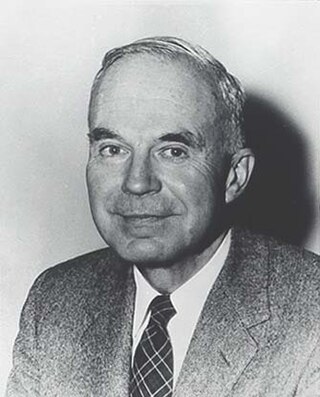
Walker Kirtland Hancock was an American sculptor and teacher. He created notable monumental sculptures, including the Pennsylvania Railroad World War II Memorial (1950–52) at 30th Street Station in Philadelphia, and the World War I Soldiers' Memorial (1936–38) in St. Louis, Missouri. He made major additions to the National Cathedral in Washington, D.C., including Christ in Majesty (1972), the bas relief over the High Altar. Works by him are presently housed at the U.S. Military Academy at West Point, the Library of Congress, the U.S. Supreme Court, and the United States Capitol.
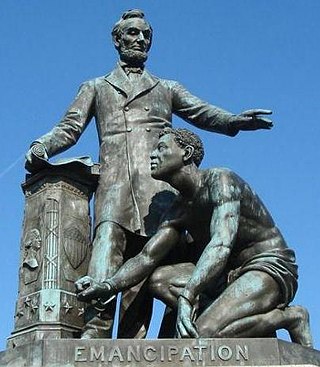
The Emancipation Memorial, also known as the Freedman's Memorial or the Emancipation Group is a monument in Lincoln Park in the Capitol Hill neighborhood of Washington, D.C. It was sometimes referred to as the "Lincoln Memorial" before the more prominent national memorial was dedicated in 1922.

Zenos Frudakis, known as Frudakis, is an American sculptor whose diverse body of work includes monuments, memorials, portrait busts and statues of living and historic individuals, military subjects, sports figures and animal sculpture. Over the past four decades he has sculpted monumental works and over 100 figurative sculptures included within public and private collections throughout the United States and internationally. Frudakis currently lives and works near Philadelphia, and is best known for his sculpture Freedom, which shows a series of figures breaking free from a wall and is installed in downtown Philadelphia. Other notable works are at Arlington National Cemetery in Virginia, Brookgreen Gardens in South Carolina, the National Academy of Design, and the Lotos Club of New York City, the Imperial War Museum in England, the Utsukushi ga-hara Open Air Museum in Japan, and the U.S. Embassy in Pretoria, South Africa.

Mary McLeod Bethune Memorial is a bronze statue honoring educator and activist Mary McLeod Bethune, by Robert Berks.
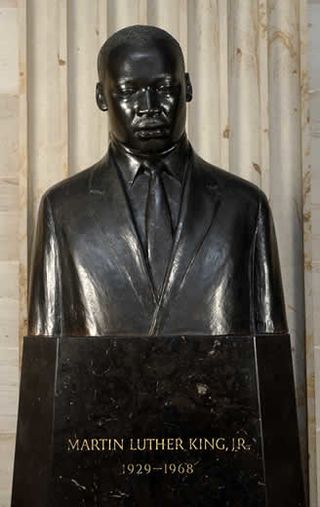
A bust of Martin Luther King Jr. by the American artist John Woodrow Wilson is located at the United States Capitol rotunda in Washington, D.C.
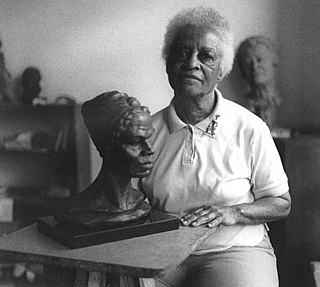
Ruth Inge Hardison was an American sculptor, artist, and photographer, known particularly for her 1960s busts entitled "Negro Giants in History". Hardison's 1983 collection called "Our Folks", which features sculpted portraits of everyday people, is also of note. Her artistic productions largely surround historical black portraiture. She was especially interested in creatively representing the unspoken voices of the African American past. She was the only female in the Black Academy of Arts and Letters (BAAL), a group that encourages awareness of black artistic accomplishments, when this organization was founded in 1969.
The history of the 1954 to 1968 American civil rights movement has been depicted and documented in film, song, theater, television, and the visual arts. These presentations add to and maintain cultural awareness and understanding of the goals, tactics, and accomplishments of the people who organized and participated in this nonviolent movement.

A bronze bust of Martin Luther King Jr. was made by African-American artist Charles Alston in 1970, two years after King was assassinated. Alston received a commission from the Reverend Donald S. Harrington, of the Community Church of New York, to create a bust of King for $5,000. Five bronze busts were cast in 1970, each approximately 32 centimetres (13 in) high.
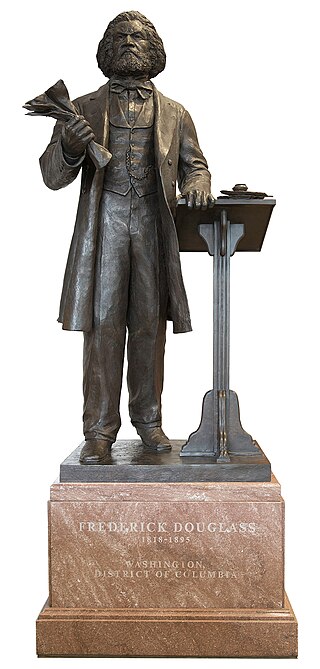
Frederick Douglass is a 2013 bronze sculpture depicting the American abolitionist and politician of the same name by Steven Weitzman, installed in the United States Capitol Visitor Center's Emancipation Hall, in Washington, D.C.
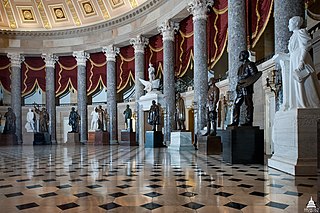
The United States Capitol displays public artworks by a variety of artists, including the National Statuary Hall Collection and United States Senate Vice Presidential Bust Collection.

The Emancipation Memorial, also known as the Freedman's Memorial or the Emancipation Group was a monument in Park Square in Boston. Designed and sculpted by Thomas Ball and erected in 1879, its sister statue is located in Lincoln Park in the Capitol Hill neighborhood of Washington, D.C. The Boston statue was taken down by the City of Boston on December 29, 2020, following a unanimous vote from the Boston Art Commission on June 30 to remove the memorial.